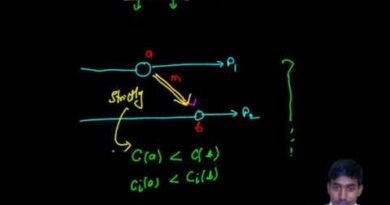Phases of Distributed System or Architecture of Distributed System-distributed application
Phases of Distributed System or Architecture of Distributed System-distributed application.
Contents
- 0.1 Phases of a Distributed System & Architecture of Distributed Systems
- 0.2 1. Phases of a Distributed System
- 0.3 1.1. Design Phase
- 0.4 1.2. Development Phase
- 0.5 1.3. Deployment Phase
- 0.6 1.4. Execution and Coordination Phase
- 0.7 1.5. Monitoring and Maintenance Phase
- 0.8 2. Architecture of a Distributed System
- 0.9 2.1. Client-Server Architecture
- 0.10 2.2. Peer-to-Peer (P2P) Architecture
- 0.11 2.3. Three-Tier Architecture
- 0.12 2.4. Microservices Architecture
- 0.13 2.5. Event-Driven Architecture
- 0.14 3. Distributed Applications
- 0.15 Examples of Distributed Applications:
- 0.16 Phases of Distributed System or Architecture of Distributed System-distributed application
- 0.17 Module 1 – Distributed System Architectures & Models
- 0.18 Module 2 Distributed System Architectures
- 1 🏗️ Architecture of a Distributed System
- 2 🔁 Phases of Distributed System Development
- 3 🗺️ Common Architectures of Distributed Applications
- 4 ✅ Summary
Phases of a Distributed System & Architecture of Distributed Systems
A Distributed System consists of multiple interconnected computers that communicate and coordinate to achieve a common goal. It ensures scalability, fault tolerance, and resource sharing.
1. Phases of a Distributed System
A distributed system follows these key phases:
1.1. Design Phase
- Identifying system requirements (scalability, fault tolerance, performance).
- Choosing an architecture model (Client-Server, Peer-to-Peer, Microservices).
- Selecting communication protocols (RPC, REST, gRPC, Message Queues).
1.2. Development Phase
- Implementation of services and components.
- Writing distributed algorithms for coordination and synchronization.
- Incorporating security features (encryption, authentication).
1.3. Deployment Phase
- Deploying distributed applications across multiple nodes.
- Setting up load balancing and fault tolerance mechanisms.
1.4. Execution and Coordination Phase
- Managing distributed transactions and ensuring consistency.
- Synchronization and message passing (e.g., logical clocks, vector clocks).
1.5. Monitoring and Maintenance Phase
- Fault detection and recovery (failure handling mechanisms).
- Performance monitoring and scaling (horizontal/vertical scaling).
2. Architecture of a Distributed System
The architecture defines how different components interact. There are several models:
2.1. Client-Server Architecture
- Clients send requests; servers process and respond.
- Example: Web applications (browsers communicate with web servers).
2.2. Peer-to-Peer (P2P) Architecture
- All nodes are equal, and each can act as a client or server.
- Example: Torrent file sharing, blockchain networks.
2.3. Three-Tier Architecture
- Divides the system into three layers:
- Presentation Layer (User Interface)
- Application Layer (Business Logic)
- Data Layer (Database)
- Example: E-commerce applications.
2.4. Microservices Architecture
- Applications are broken into small, independent services.
- Each service communicates via APIs.
- Example: Netflix, Amazon, modern cloud-based applications.
2.5. Event-Driven Architecture
- Components communicate asynchronously through events.
- Example: IoT applications, real-time stock trading platforms.
3. Distributed Applications
A Distributed Application runs on multiple machines but appears as a single system.
Examples of Distributed Applications:
- Cloud Computing (AWS, Google Cloud, Azure)
- Databases (MongoDB, Cassandra, Hadoop)
- Messaging Systems (Kafka, RabbitMQ, MQTT)
- Blockchain and Cryptocurrency Networks
Would you like details on a specific architecture or an example of a distributed application?
Phases of Distributed System or Architecture of Distributed System-distributed application
Module 1 – Distributed System Architectures & Models
Module 2 Distributed System Architectures
Here’s a detailed explanation of the Phases of a Distributed System (or its architecture), especially in the context of a distributed application:
🏗️ Architecture of a Distributed System
A Distributed System is a collection of independent computers that appear to the users as a single coherent system. It is built in layers/phases that represent how different components interact.
🔄 1. Hardware Layer
-
Nodes/Machines: The physical servers, desktops, mobile devices, etc.
-
Can be homogeneous (same type) or heterogeneous (different architectures/platforms).
-
Connected via network (LAN/WAN, Internet).
📡 2. Network Layer
-
Provides communication between machines.
-
Protocols: TCP/IP, UDP, gRPC, etc.
-
Handles:
-
Message transmission
-
Fault detection (timeouts, retransmissions)
-
Basic security (TLS)
-
🖥️ 3. Operating System Layer
-
The OS abstracts the hardware and manages local resources (files, processes).
-
Also provides network access APIs (e.g., sockets).
-
Often handles process scheduling, local concurrency, memory management.
🧱 4. Middleware Layer (💡 Core of distributed systems)
-
Sits between the OS and the distributed application.
-
Provides abstractions and services like:
-
Remote Procedure Calls (RPC) / Remote Method Invocation (RMI)
-
Message Passing (e.g., Kafka, RabbitMQ)
-
Naming Services
-
Security services
-
Data serialization/deserialization
-
Fault tolerance mechanisms
-
🧠 Examples: CORBA, gRPC, Java RMI, REST APIs, DDS, .NET Remoting.
🧩 5. Application Layer (Distributed Applications)
-
This is where the actual distributed application logic resides.
-
Examples:
-
Distributed databases (Cassandra, MongoDB)
-
Cloud services (e.g., Google Docs, Netflix)
-
Multiplayer games
-
Microservices
-
Blockchain networks
-
🔁 Phases of Distributed System Development
Phase 1: Requirement Analysis
-
Define the goals (e.g., scalability, consistency, fault-tolerance).
-
Determine system topology (peer-to-peer, client-server, hybrid).
Phase 2: System Design
-
Choose architecture: centralized, decentralized, or hybrid.
-
Select middleware, communication protocols, data formats.
-
Design failure recovery and synchronization strategies.
Phase 3: Implementation
-
Develop system components and integrate middleware.
-
Use programming models: RPC, message queues, event-driven, etc.
Phase 4: Deployment
-
Deploy on cloud/on-premise infrastructure.
-
Manage scaling, node registration, service discovery.
Phase 5: Monitoring & Maintenance
-
Track system health (latency, load, failure rate).
-
Handle upgrades, logging, alerting, dynamic scaling.
🗺️ Common Architectures of Distributed Applications
| Type | Description | Example |
|---|---|---|
| Client-Server | Clients request, server responds | Web apps, REST APIs |
| Peer-to-Peer | All nodes are equal, decentralized | BitTorrent, blockchain |
| Three-tier | Presentation → Logic → Data | Enterprise apps, ERPs |
| Microservices | Multiple small services communicate | Netflix, Amazon |
| Service-Oriented | Services are loosely coupled | SOAP, WSDL-based architectures |
✅ Summary
-
A distributed system consists of multiple layers: hardware → network → OS → middleware → application.
-
Middleware plays a critical role in hiding distribution complexities.
-
Distributed applications leverage this architecture to provide scalable, fault-tolerant, and efficient services.
Would you like a diagram of the architecture, or a comparison of distributed vs centralized systems next?


